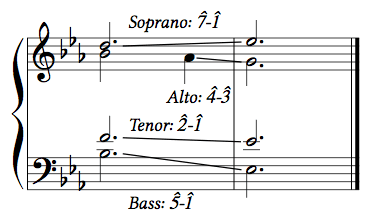In my last blog post, I identified the gestures that compose the Latter-Day Saint hymn “Father in Heaven, We Do Believe.” Today I’ll show how these gestures are elaborated and how all these elements work in concert to make the arrival on “we receive” so striking.
How are they elaborated?
In the first phrase, the harmony of 1-6-2-5 follows close to its ideal form, with only a seventh added to the alto to smooth the voice leading.

In addition this gesture, along with all the others, is given a more specific rhythm. Such repetitions are perhaps the simplest embellishment a composer can make, but they’re sometimes forgotten.

The descending tetrachord has a fascinating elaboration.
One beautiful detail is how the soprano in bars 4-5 foreshadows the gesture by imitation (G–F–E-flat to C–B-flat–A–flat).
Furthermore, instead of using the near-sustained soprano (see ex. 3a), Crawford moves the soprano in contrary motion to the bass. The octave transfer in the bass concurrent to the chromatic alteration of the soprano highlight and strengthen the motion into the cadence.[1. Pre-19th century musicians classified cadences based on the which voice of the characteristic V-I resolution was in the bass:
Because the voice-leading of this cadence moves down by step to the root of the chord, it would be considered a tenor cadence.]
The bass of the 1-6-4-5-1 follows its schemata with minimal alterations. In bar 11, she writes a voice exchange that sets up expanding contrary motion into the 6/4 over the dominant. That expanding contrary motion gracefully parallels that of bars 10-11.


Crawford’s changes to the soprano line are more significant. The tenor and the soprano swap places in bars 10-11, as do the alto and the soprano in the antepenultimate[2. This word will be forever associated in my mind with Tom Durham’s theory classes at BYU.] bar. Artistically, these changes allow Crawford to create a lovely chain of upward motions in the soprano (G-C, A-flat–B-flat, F-G). Craft-wise, they cause her to change the tenor line in bar 9 to improve the voice leading.
Why is the arrival on “we receive” so striking?
The arrival on “we receive” is one of the most satisfying moments of this hymn. The magic of this climax can be explained initially by the arrival on the subdominant chord (A-flat). Crawford highlights this harmony (1) by the leap out of the soprano’s theretofore constricted tessitura, (2) by having withheld a true subdominant till that point (the A-flat in bar 6 supports a ii6), and (3) by giving it the longest harmonic rhythm to this point.[3. i.e., creating a agogic accent in the harmonic rhythm.]
But these aren’t the only ways that Crawford has prepared this moment to be special.
Because phrase 2 begins almost identically as phrase 1, one would presume both phrases to share the 1-6-2-5 model. The use of the subdominant at bar 10 thwarts the listener’s expectation of supertonic. These parallel openings going different directions can be thought of as a kind of musical alliteration.
Yet, while this arrival contradicts our surface expectation, it fulfills our structural hope. As we hear the three surface harmonic gestures, a fourth emerges, unifying the three on the background level: a Romanesca, more commonly known as the “Pachelbel’s canon” bass. It’s often followed by a bass cadence after its first five notes, as shown here:

Crawford draws our attention to the Romanesca by placing its soprano and bass on the gesture boundaries of phrase 1:

Temporarily suspended, this pattern reaches its fulfillment at the climax in bar 8 — the precise point to which Crawford has drawn our attention through other means. At this point, background (the Romanesca) and foreground (the 1-6-4-5-1) converge for the hymn’s final cadence.
As this is a background gesture, it’s not easy to hear. The recording speeds the piece twice and reinforces the Romanesca notes in a flute and bass clarinet. Once you’ve listened several times to the generic Romanesca (ex. 6) and the highlighted version (ex. 7), go back and listen to the original:
Conclusion
This hymn shows well Gabriel Fauré’s dictum, “You don’t have to be a genius in every bar.” Crawford follows her models closely, and even if her disposition and elaboration of them were likely unconscious,[4.Obviously, it’s doubtful that Crawford consciously deployed this Romanesca in tandem with the surface gestures. I also doubt she would have explained her hymn’s harmony as I have. But as a Western musician, Crawford’s knew these models, even if unconsciously. And as I will continue to show, they saturate most Western music.] they show how little it takes to turn stock gestures into meaningful, original music. Crawford’s trick wasn’t using strange chords or unusual progressions, but rather ordering and elaborating common gestures in a unique and focused way.[5. That arrival on “we receive” lending the piece its focus.]
Notes
Don’t Miss Next Week’s Post
Sign up to stay in the loop about my music—and ideas for your own composing!


